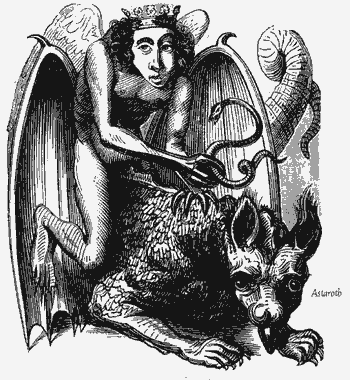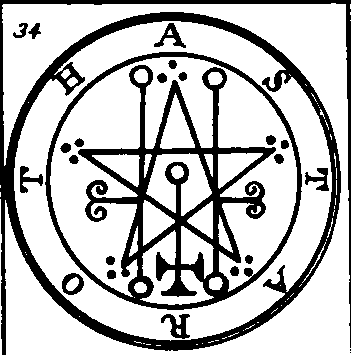 Duke
commanding 40 legions
Duke
commanding 40 legions
Appears as a “hurtful” angel riding an infernal, dragon-like
beast and carrying a viper in his right hand
Powers: tells fortunes; teaches liberal sciences
Astaroth is mentioned in a variety of sources, each offering contradictory
identification. In Arthur Waite’s The book of Black Magic and
of Pacts,before
Astaroth fell he was a prince of the order of thrones. In Spence’s
An Encyclopedia of Occultism, Astaroth belonged to the order of seraphim.
The Grimorium Verum maintains that Astaroth has set up residence in
America.
In The Lemegeton, Waite refers to Astaroth as a great duke in the
infernal regions, whereas according to Barrett in The Magus, he is
called Diabolus in the Greek language. It is said that when he is
invoked Astaroth manifests as a beautiful angel astride a dragon carrying
a viper in his right hand. According to Voltaire, Astaroth was an
ancient god of Syria, whereas De Plancy argues that he was one of
the seven princes of hell who visited Faust.
Astaroth ( also Ashtaroth ). A male demon who evolved from the ancient
Phoenician mother goddess of fertility, Astarte or Ashtoreth. In his
male incarnation, he has little to do with man’s sexual nature.
He is a teacher of the sciences and a keeper of the secrets of the
past, present and future and is invoked in necromantic rituals of
divination. He appears as an angel in human form, by some accounts
ugly and by other accounts beautiful. He does, however, possess a
powerful stench. Weyer said Astaroth was a grand duke of hell and
commanded 40 legions of demons. Astaroth is listed as one of the three
supreme evil demons, with Beelzebub and Lucifer, in the Grimoire Verum
and Grand Grimoire, which date from about the 18th century.
The demon is said to instigate cases of demonic possession, most notably
that of the Loudun nuns in France in the 16th century. The nuns accused
a priest, Father Urbain Grandier, of causing their possession. At
Grandier’s trial, a handwritten “confession” of his
was produced detailing his pact with the Devil, witnessed and signed
by Astaroth and several other demons
Sources:
Barrett, Francis. The Magus. New Hyde Park,N.Y.;University Books,1967.
Davidson, Gustav. A Dictionary of Angels: Including the Fallen Angels.
1967. Reprint. New York: Free Press, 1971 Spence, Lewis. An Encyclopedia
of Occultism. Rev.ed.New Hyde Park,
N.Y.; New York University Books, 1974.
Waite, Arthur Edward. The Book of Black Magic and Ceremonial Magic:The
Secret Tradition in Goetia including the rites and mysteries of Goetic
theurgy, sorcery and infernal necromancy. New York: Causeway Books,
1973.
 *(Aleister
Crowley's interpretation)
*(Aleister
Crowley's interpretation)